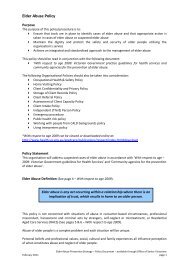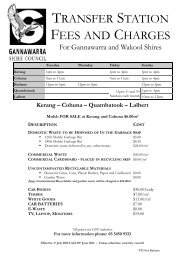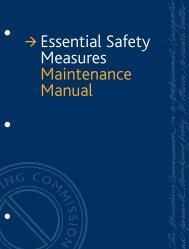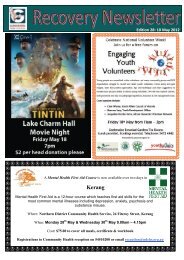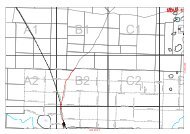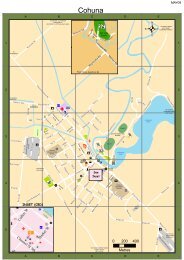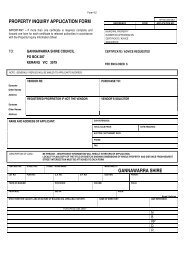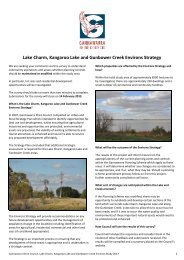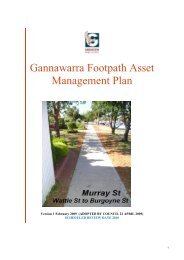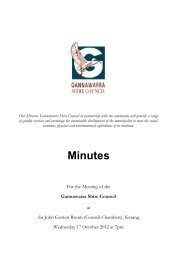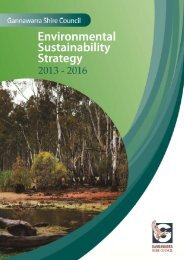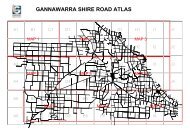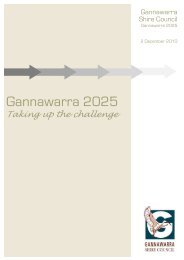Southern Loddon Mallee Regional Strategic Plan 1 - Macedon ...
Southern Loddon Mallee Regional Strategic Plan 1 - Macedon ...
Southern Loddon Mallee Regional Strategic Plan 1 - Macedon ...
Create successful ePaper yourself
Turn your PDF publications into a flip-book with our unique Google optimized e-Paper software.
Basis for action:<br />
Our region’s natural ecosystems, rural landscapes and water<br />
catchments are critical to its attractiveness, liveability and economy<br />
and are a unique part of its cultural heritage. Our settlements<br />
are surrounded by forest, with Box-Ironbark Forests and National<br />
Parks creating our unique greenbelts. Forest and valued rural<br />
landscapes are both in public and private land and their protection<br />
and enhancement will also contribute to our tourism attraction.<br />
Pressures from climate change, land use, fire and its management,<br />
pests and management neglect pose a threat to these values and<br />
may lead to a decline in environmental condition. Investment<br />
and management intervention are required to ensure natural<br />
environments and farming systems remain resilient.<br />
Our natural environments are among the more disturbed in the<br />
state. Most of our remaining areas of native vegetation have<br />
experienced multiple cycles of disturbance from historical land<br />
uses, such as mining, livestock grazing, timber and firewood<br />
production. Introduction and spread of pest plants and animals<br />
has added to the disturbance.<br />
Despite this history of clearing, settlement and land use, some<br />
native vegetation remains to support our diverse populations<br />
of native flora and fauna. The largest and most intact natural<br />
environments are generally located in our National Parks and other<br />
conservation reserves. However, vegetation along road reserves,<br />
in drainage lines and scattered across private landholdings provide<br />
connectivity between theses and make an important contribution<br />
to the region’s biodiversity and visual amenity.<br />
Our region includes parts of the upper and middle reaches of<br />
the Campaspe, Coliban and <strong>Loddon</strong> Rivers. These are important<br />
catchment areas and help to provide water for our urban<br />
populations, our riverine and wetland habitats and for dryland<br />
and irrigated agriculture. Our landscapes and soils support various<br />
forms of primary production, including agriculture, horticulture<br />
and forestry. They and the vegetation they support are important<br />
sinks for atmospheric carbon dioxide.<br />
The greatest risks to sustaining our natural environment are climate<br />
change, population growth, fire and its management and rural<br />
land use change. Several important influences may at least partly<br />
reduce risks associated with these hazards. These include a greater<br />
appreciation and understanding of natural environments and the<br />
services they provide, including through the landcare movement;<br />
investment into regional natural resource management initiatives;<br />
controls on vegetation clearing; improved operation of water<br />
markets; modernisation of irrigation infrastructure and investment<br />
in environmental water provision.<br />
Built heritage<br />
In addition to providing tourism opportunities, the built heritage<br />
from the goldfields is a defining characteristic of the Region: from<br />
the grand architecture of Pall Mall in Bendigo, or more simple<br />
pieces of infrastructure like the Malmsbury Reservoir water-race<br />
and humble miners cottages. This built heritage enhances quality<br />
of life and should be conserved for present and future residents to<br />
enjoy.<br />
Bushfire<br />
Following the Black Saturday bushfires of 2009, issues of human<br />
safety in forested urban fringe areas have come to the fore. There is<br />
strong pressure to manage bushfire risk in these areas. A challenge<br />
in doing so and implementing recommendations from the 2009<br />
Bushfires Royal Commission will be to manage threats in a way that<br />
does not compromise the ecological values associated with these<br />
important areas. A collaborative approach between the CFA, DSE<br />
and landowners will be required.<br />
Biolinks<br />
Our region retains many important natural ecosystems with<br />
high conservation and amenity value including riverine and<br />
wetland ecosystems along the major rivers and their floodplains;<br />
Box-Ironbark and Stringybark Forests through the Goldfields and<br />
along the Great Dividing Range; and grassy woodlands of the<br />
<strong>Loddon</strong> and Campaspe Plains. We host some of Victoria’s priority<br />
biodiversity conservation zones, including parts of the Goldfields<br />
‘flagship area’ (one of 14 such areas in the State) and the regional<br />
biolink connecting major segments of the Goldfields flagship area<br />
with each other and the Murray River flagship area.<br />
One of the key means of improving the resilience of natural<br />
environments and maintaining ecological function is to improve<br />
their connectivity of landscapes. Establishment of such ‘biolinks’<br />
is one of the three main platforms of the Victorian Government’s<br />
white paper for land and biodiversity at a time of climate change<br />
and forms part of our region’s aspiration for the future. Action<br />
is required to identify priority areas for improving landscape<br />
connectivity, including by better understanding ecological and<br />
Aboriginal and Torres Strait Islander cultural heritage values<br />
associated with remnant vegetation areas. A regionally coordinated<br />
program of planning and implementation is needed to protect<br />
and manage priority remnants and restore landscape connectivity<br />
where it is currently deficient. The program is also required to more<br />
strong engage communities in management and restoration of<br />
natural environments and would be implemented on both public<br />
and private land.<br />
Environmental markets are one of the tools favoured by the<br />
Victorian Government to mobilise the capital and resources<br />
required to enhance natural environments. These markets create<br />
value for landholders from activities that protect or enhance land,<br />
water and/or biodiversity. Markets for carbon sequestered by trees<br />
established for such purposes represent one of the most promising<br />
environmental market opportunities.<br />
This will require strong support from landholders and the<br />
broader community and significant capital and labour resources.<br />
Environmental markets, which generate value for landowners<br />
from improved environmental management outcome, provide<br />
the opportunity for private landholders to actively participate<br />
and derive benefit from the protection of native vegetation and<br />
ecosystems. Programs such as ‘Bushtender’ that promote the<br />
benefits of protecting the natural environment that so strongly<br />
characterises this region should be strongly supported. Our region<br />
also has active Landcare groups who continue to work with rural<br />
landholders and the community, promoting good natural resource<br />
management.<br />
Climate change<br />
Climate change projections for our region are similar to those for<br />
elsewhere in northern Victoria. The climate is projected to become<br />
warmer and drier and as a consequence, streamflows are projected<br />
to fall, droughts are projected to become more intense and<br />
bushfire danger is projected to increase.<br />
<strong>Southern</strong> <strong>Loddon</strong> <strong>Mallee</strong> <strong>Regional</strong> <strong>Strategic</strong> <strong>Plan</strong> 35



